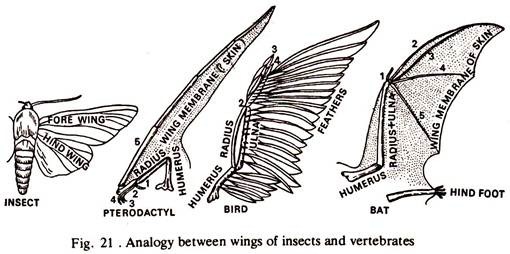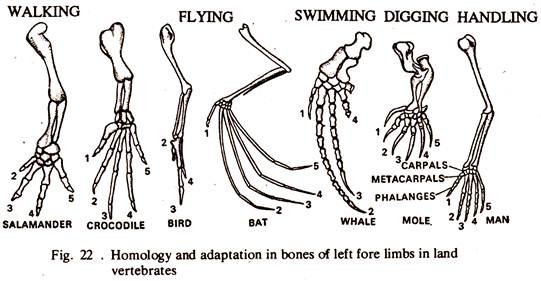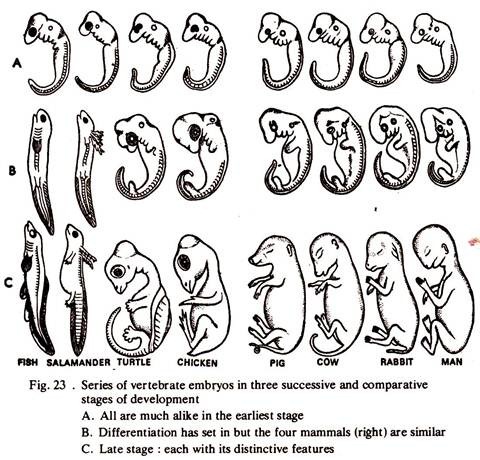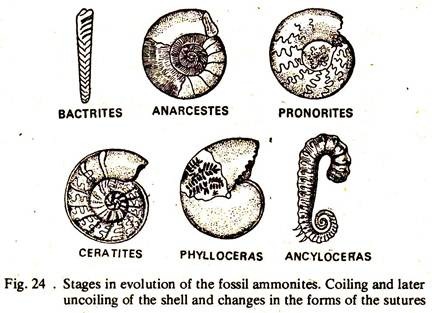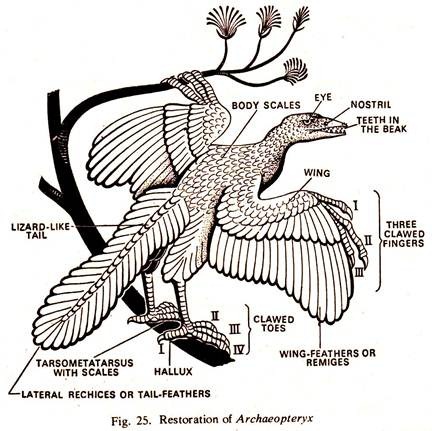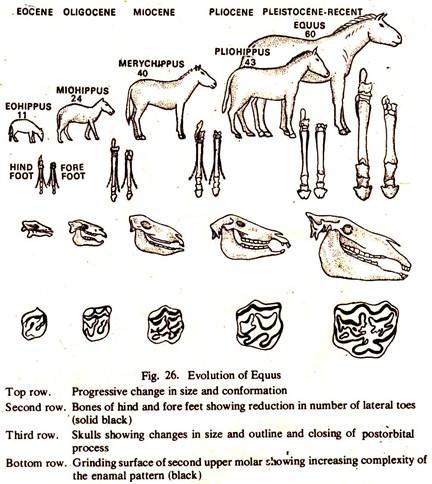In this article we will discuss about the evidences and theories of organic evolution.
The Evidences of Organic Evolution:
Organic Evolution is a process by which organism changes itself to adapt best with the environment. It, in fact, signifies that animals after their origin, have descended from their ancestors with modifications, resulting in the variety of today.
The complex animals and plants of today are the result of a series of slow and steady changes of simpler-forms of the by-gone days through generations which have taken place during millions of years.
The principle of evolution is supported by numerous facts or evidences, which are apparently indirect and can be summed up under the following heads.
1. Evidences from Comparative Anatomy or Morphology:
ADVERTISEMENTS:
(a) Basic relationship:
A basic relationship exists between all animals from lowly organized to most highly evolved, in the structure and composition of protoplasm and cells. The cells, however, exhibit difference in shape and size in response to functions but their fundamental constitution remains unchanged.
Throughout the animal kingdom the protoplasm contains very nearly the same elements almost in the same proportions of proteins, carbohydrates, fats, water and other substances.
(b) Homologous organs:
ADVERTISEMENTS:
Homologous organs are those which are developmentally alike and may or may not perform similar functions. The limbs, brains, hearts, etc. of different vertebrates are homologous organs.
Thus the skeletal elements in the wings of pterodactyls (extinct flying reptiles) birds and bats are homologous in that all are modifications for flight of the common pattern of fore limb in land vertebrates.
The wings of insects are analogous to those of vertebrates, although used for flight, they are derived not from limbs, but presumably as extension of the body wall (Fig.21).
Homologous structures are present in different groups of animals. The fore and hind limbs of different vertebrates are pentadactyl (Fig.22).
ADVERTISEMENTS:
A comparison of the fore limbs of salamander, crocodile, bird, bat, whale, mole and man shows that the limbs are homologous in being composed of comparable bones, which in each group of animals are adapted for special uses by differences in the length, shape and bulk of various bones.
Fore limbs of salamander and crocodile are used for walking, those of birds and bats help in flying, and that of whale for swimming, mole for digging and man for handling objects.
In all vertebrates the heart is ventrally placed and circulation takes place through a closed system of vessels, arteries and veins. A gradual evolution towards perfection is found in different classes of vertebrates. It is two-chambered in fishes, three-chambered in amphibians and reptiles and four-chambered in birds and mammals, completely separating the arterial and venous blood.
The presence of identical organs in different groups of vertebrates can only be explained by accepting that all of them are descendants of a common ancestor, from whom they inherited these structures, but as they are variously modified, the minute structural differences are due to various life conditions to which they have been subsequently adapted.
(c) Connecting links:
It is proved that the mammals, like the birds, have evolved from reptiles. But, these two groups of animals are widely separated by striking differences, which, however, may be thought to be bridged over, if some intermediate animals with some common characters are found.
Monotremes are animals found in Australia, in which most important characters of reptiles and mammals are combined and serve as a link between these two groups. They possess hairs and mammary glands like the mammals but lay eggs like reptiles and again suckle the young after hatching. It is presumed that monotremes are in the making of mammals from reptiles.
ADVERTISEMENTS:
The fossil bird Archaeopteryx (Fig. 25) connects the reptiles with the birds. This bird had teeth and long tail like reptiles and wings with feathers similar to birds.
(d) Vestigeal organs:
Organs which were once well developed and functional but have been rendered functionless due to change of environment and are in the way of degeneration, are known as vestigeal organs.
The handful of bones in the pelvic girdle of whales, the small amount of flesh (rudimentary nictitating membrane) at the inner corners of our eyes, the caecum, and the coccyx in man, the pair of vestigeal wings in the flightless New Zealand Kiwi are the examples of vestigeal organs. Their presence indicates that the possessors have originated from a group of animal in which these structures were functional.
2. Evidences from Embryology:
The law of embryo-genic development states (a) General characters appear in development prior to special characters, (b) From the general, the less general, and ultimately the special characters develop, (c) During development an animal gradually drifts progressively from other animals, (d) Young stages of an animal resemble the embryonic or young stages of lower animals but are unlike the adult of those animals.
A common basic plan of development with similar embryonic stages exists in different classes of vertebretes (Fig. 23). All of them in their foetal stages possess visceral clefts and a visceral skeleton, though not used for respiration in true land vertebrates, viz. the reptiles, birds and mammals.
Certain larval stages are common to some groups of invertebrates also. The trochophore larva is found both in Annelida and Mollusca; the nauplius larva is common to most of the orders of the class Crustacea.
All vertebrate embryos develop a series of aortic arches (usually six) running from the ventral aorta to the dorsal aorta similar to Branchiostoma (amphioxus). In course of development the number of aortic arches are reduced to five in sharks, four in teleosts, three in amphibia and reptiles and two in birds and mammals.
From the development of some organisms it is revealed that in some cases the embryos do not resemble the parents but resemble the adults of lowly evolved animals. The tadpole larval stage of frogs and toads is exactly like a fish. It is believed that the larval stages of an animal repeat the structures of the ancestor from which it has evolved.
This is also known as ‘Ontogeny recapitulates Phytogeny’, or the development of an individual repeats the evolution of the race in a condensed form. Now-a-days this principle is used in a very limited sense, because the pattern of development is liable to alternations to some degree, due to the influence of the environment and also the amount of yolk present in the egg.
3. Evidences from Palaeontology:
Palaeontology is the science of fossils. Fossils are the remains of animals and plants of the by-gone days and are of six types. Fossils are present in different layers of earth’s crusts.
Lower the layer, older is the age of the organisms and the reverse. The age of a geologic strata may be accurately determined by either lead method or radio-carbon method. The oldest era with animal fossils for certain is the Proterozoic (2,000 million years).
Beginning with invertebrates (505 million years), reptiles (255 million years) appeared in the Paleozoic era (505-230 million years). Birds and small mammals evolved in the Mesozoic era (205-135 million years) or the age of reptiles, when dinosaurs reached peak and became extinct. The last or Cenozoic era (75-0 million years) has been marked by the rise to dominance of mammals and man, and is still in progress.
Fossil records definitely indicate trend of evolution through different era.
Mollusca:
The trends of evolution of fossil ammonites (Cephalopoda) reveal coiling at the initial stage, and uncoiling of the shell at a later period. Structures between successive chambers were simpler in the older stocks and more complex in those of later periods.
The first chambers formed by some of the later ammonites were simple, like those of their ancestors. Then, surprisingly, some of the last ammonites had simpler sutures again and their shells were coiled in the young but straight in the adult stages. Finally, the entire line of ammonites ended in the Cretaceous period (Fig. 24).
Archaeopteryx:
An extinct bird, possessed feather like most birds but unlike them had homodont reptilian teeth and a less developed forelimb (Fig.25). These explain that Archaeopteryx represents a stage in the evolution of birds from reptilian ancestors. Birds appeared later than mammals but very soon they became specialized and static.
The mammals were in the process of continuous change, the primitive egg laying forms gave rise to more specialised ones, first the marsupials, then the placentals. From the study of the fossils, complete evolutionary histories of horse, camel and elephant have been revealed and we can read the story step by step.
Evolution of the Horse:
The history of the horse covers a period of 50 million years beginning in the Eocene period. The known ancestor of the present day horse Equus was Hyracotherium (including Eohippus of others).
The browsing, less than one foot high ancestral, horse changed through Mesohippus (Oligcene, 39 million years), Miohippus, Parahippus, Merychippus (Miocene, 28 million years), and Pliohippus (Pliocene, 12 million years) to Equus (Pleistocene to recent 1-0 million years).
The evolution of Equus from Eohippus is a history of the enlargement of the body both in length and girth, loss of digits in both pairs of limbs, transformation of low-crowned cheek teeth to high-crowned and highly specialised for grinding coarse, siliceous grasses, associated with many other changes (Fig.26).
Fossil records also suggest that a number of animals have become extinct for various reasons. This is very conspicuous in reptiles. Dinosaurs (large lizard-like), pterodactyls (flying reptiles) and ichthyosaurs (fish-like reptiles) are all extinct.
Fossilization and types of fossils:
(a) Preservation of hard parts:
The endoskeleton of vertebrates and exoskeleton of invertebrates are preserved unaltered. From such fossils it is possible to get some idea about the shape, size and posture of animals.
(b) Foot prints:
The foot prints left on soft mud are preserved by subsequent hardening of the mud into rock. These provide clues for body structure, locomotory organs and mode of locomotion of animals.
(c) Petrified fossils:
The organic substances of the body are replaced by inorganic substances particle by particle in minute detail and an exact duplicate is left. The replacement is so perfect that muscle fibres with cross striations are recognised.
For the formation of petrified fossil the organism or part of it must be embedded and buried in some soft medium. This may happen either at the bottom of a body of water or on land by accumulation of wind-blown sand, soil or volcanic ash.
The dead, body is subsequently covered with layers of mud. The organic substances of the body are slowly replaced by minerals from the surroundings and gradually turn to hard rock.
Sedimentary rock containing fossils may be carried by the rivers to sea, where it sinks to the bottom, and deposited in subsequent layers. Entire body or parts of organisms are often included in these layers.
(d) Mould and Casts:
The natural moulds of organisms are formed by hardening of materials surrounding buried bodies, which later disintegrate and are removed by seepage of the ground; leaving a hollow cavity. It presents the exact external features of the organism buried. The soft animals like Jelly fish, worms etc. are preserved in this way.
(e) Amber preservation:
Sometimes delicate animals, viz. crustaceans, insects, spider etc. are preserved in oil shales, asphalt, amber etc.
(f) Ice preservation:
The carcass of many animals are preserved as such within ice at sub-zero temperature. Wooly mammoth, rhinoceros of past have been recovered from Siberian ice.
4. Evidences from Geographical Distribution:
The distribution of animals and plants on the earth’s surface is not uniform. Every country has its peculiar flora and fauna. Elephants are found in Africa and Asia, Tigers in parts of Asia, Rhinoceros in Africa and India, Kangaroos in Australia and South America, Lions in India-and Africa, and so on. Particular species of organism evolves at a particular place and with the increase in number they migrate in all available directions.
Climatic conditions in no two places are exactly alike and the organisms exhibit modifications. Due to different barriers, populations are separated or isolated. Mutations appear in the population and isolation prevents the spread of the changes to other populations. This is continued and gradually by accumulation of more mutations one or more new species are formed from a population.
5. Evidences from Comparative Physiology and Biochemistry:
Comparative physiology and comparative biochemistry lend much support to the idea of evolution. In addition to cells, the basic structures of chromosomes, the physical basis of heredity, in diverse organisms are similar.
Throughout the living world, the chromosomes consist of basic proteins in combination with nucleic acid. Histone and protamine, the simplest types of proteins predominate, but globulin and some incompletely identified proteins, probably contributing to the diversity of hereditary materials are also present.
(a) Enzymes, hormones and hematin crystals:
Identical or closely similar enzymes and hormones are common to large groups of animals. Digestive enzyme, viz. trypsin (proteolytic enzyme) is common in animals Protozoa to Mammalia. Amylase (starch-splitting enzyme) has been recorded from sponges to man.
The thyroid hormone is found in all vertebrates and it is interchangeable, i.e. beef thyroid can be used to meet thyroid deficiency in man. Metamorphosis of a tadpole larva continues if it is fed with mammalian thyroid after the removal of its own thyroid gland.
Various classes of vertebrates can be distinguished on the basis of haematin crystals alone prepared from the haemoglobin. The crystals differ from species to species in structural details and they parallel the present classification. Crystals from different species of a genus share many common characteristics, and crystals from different classes also have some common structures.
(b) Comparative serology:
Impressive physiological evidences have been drawn from the study of comparative serology. If a small amount of blood serum of an animal is injected into another animal, viz. guinea pig or rabbit or other test animals the foreign blood acts as an antigen and antibodies are produced in the blood of the test animal.
If a second injection is given to the test animal with the serum from the first animal, the antibodies precipitate and destroy the antigen. The test animal is then said to be immunized to the particular kind of blood. The precipitation occurs in the blood stream but it can be carried in test tubes by adding a few drops of antigenic serum to the antiserum obtained from immunized animal, when a precipitate will be formed.
Antigen-antibody reactions are highly specific, still the reactions take place in related species, but in ever-decreasing degrees as the relationship grows more distant. A rabbit may be immunized with the blood from Necturus, the common salamander.
If a few drops of antigenic serum from Necturus, Amphiuma, Siren and Cryptobranchus are added to different test tubes containing antiserum from the immunized rabbit, the heaviest precipitation will occur in the first tube, the second and third will give about equal precipitates but less than the first, and the fourth will give only a slight precipitate.
These suggest Necturus, Amphiuma and Siren are closely related while Cryptobranchus is a much more primitive salamander.
This method is being applied in the problems of plant taxonomy also. Here, plant proteins are antigen and rabbit is the test animal. It has been possible to ascertain the relationship between plants with antibody containing serum from immunised rabbit.
Theories of Organic Evolution:
The organisms of different ages are products of evolutionary changes. Various theories have been put forward to explain the factors or mechanism of organic evolution.
1. Darwinism:
The theory of “the Origin of Species by means of Natural Section”, also called Darwinism, was postulated by the English biologist Charles Darwin (1809-82).
All individuals and species in nature vary in their characters and all the different characters are hereditary; tendency of the organisms is to overproduce but the food and space are limited. Organisms are subjected to natural selection. Results the death’ of many individuals.
The individuals with favourable inheritable variations survive and hand over these variations to the next generation. The favourable variations increase from generation to generation and new species are formed,
Variations in nature:
Sexually reproducing individuals show variations of all degrees in size, proportions, colouration, external and internal structures, physiology and habits in nature.
Overproduction:
The number of offspring’s produced by a pair of parents is always much more than the number ultimately survive. One female toad may lay as many as 12,000 eggs but actually we never get such a big population as there are some limiting factors or checks.
Limiting factors:
Increase of population in geometric ratio faces the more slowly increased food supply and constant space restriction. Predatory animals constitute another check on population size.
If the lions on the plains of Africa were exterminated, the zebra population would increase rapidly for a time, until a new limit is imposed. Disease is another limiting factor; epidemics occur among animals, particularly if they become overcrowded.
Climate, seasonal changes, drought, severe heat in summer, severe cold in winter are also limiting factors.
The Struggle for existence:
The number of individuals increases sharply as a result of overproduction. This in turn leads to a competition among the offspring’s for food, home territory and mate. Besides there are check factors, viz., predators, diseases and the severities of natural catastrophe. Striving to survive against the odds was termed by Darwin as ‘struggle for existence’.
Darwin identified three types of struggles:
Intraspecific struggle:
Struggle amongst the members of same species. When a large number of seedlings grow under a tree from the seeds of the same plant, many of them die due to want of water and minerals, light and space.
Interspecific struggle:
Struggle against the members of different species. In a tank, carps and other fishes are devoured by carnivorous fishes and there is a decrease in the number of animals.
Environmental struggle:
Struggle against the physical environments, like earthquake, volcanic eruption, flood, etc., which kill many organisms suddenly.
A constant struggle is going on in the living world for their very existence. Variations are of common occurrence and are of three types — beneficial, harmful and indifferent.
Natural selection:
Individuals with slightly favourable variations are enable to meet the conditions of life more successfully and survive and propagate their kind. Herbert Spencer termed this process “the survival of the fittest”.
Under natural selection those lacking such variations would perish or fail to breed so that the characters which they possessed would be eliminated from the population. Thus the species in a changing environment or one that had migrated to some new environment would be gradually altered to suit the new environment.
Origin of Races and Species:
Being favoured by nature the favourable variations gradually increase in size and are handed over to a few of the many offspring’s. These increase from generation to generation which may manifest first by small differences as varieties or subspecies. Later, when isolated from one another and could not interbreed, the advantageous variations become permanent and a species is established.
A continuation of such divergence would lead in time to the production of still other species and in turn to wider differences (genus, family etc.). Thus a large number of species and larger categories of the animal kingdom have been established through the long duration of geological time.
Criticism of Natural Selection:
1. It accounts for the survival of the fittest but not the arrival.
2. Due to natural selection organisms become overspecialized and overspecialization leads to destruction.
3. It recognizes widespread occurrence of variations and its effect but does not explain their origin. Today the mechanism of inheritance is well known and a number of theories try to explain the causes of origin of variations.
4. Causes of degeneracy are not explained by natural selection.
5. It could not distinguish heritable and non-heritable variations. Heritable variations alone are important in evolution.
6. Slight variations are considered more important than the abrupt ones; abrupt changes also play an important role in species formation.
2. Neo-Darwinism:
Darwin’s theory of natural selection could not satisfactorily explain the origin of species. Since then, a large mass of evidences has been discovered, and a theory acceptable to majority of modern evolutionists has been derived from Darwin’s theory.
This is known as neoDarwinism. NeoDarwinism is really a synthesis of the findings of genetics, systematics, comparative anatomy, morphology, palaeontology, ecology, etc., and it clearly differs from Darwin’s original theory.
Different types of variability occur within a species. These are not uniformly distributed in the whole population of a species, but somewhat restricted to local population, commonly more or less isolated from their neighbours.
The population with a distinctive pattern of variable characters is given the status of a subspecies. A subspecies is considered as an incipient species, which becomes ultimately converted into a good species through natural selection.
Each species may have one or more subspecies. A complex of gene-determined characters is associated with each subspecies, and these various genes are derived by mutation from a more uniform ancestor.
The genes of a particular subspecies are not peculiar to it but are present in different subspecies in varying degrees. Individual genes are not very important. A particular combination of genes is associated with a subspecies.
These combinations are screened out by ecological factors. Agents of selection act on this gene combination, not on individual gene. Random mutation continues within each subspecies, as a result different alleles arise in different subspecies. Subspecies are at least partially geographically isolated from each other. In addition there might have ecological and physiological isolation also.
New mutations appearing in an isolated subspecies cannot be distributed in the whole population of a species. In this way mutation gradually accumulates and new species are formed ultimately.
NeoDarwinians believe that mutations which serve as raw materials for natural selection to be acted upon are very small and are likely to be overlooked in the usual genetical experiments. Large mutation being disadvantageous cannot serve as a raw material for natural selection.
Goldschmidt and his followers believe that only subspecies within a species could be formed by neoDarwinian hypothesis, and by considering .only very minor mutations significant for evolution, which are subject to very slight selection pressure, too great a burden is placed upon natural selection.
He suggests that a decisive step, the systemic mutation is necessary for the evolution of species or higher ranks. A change in the chromosome structure might induce such mutation and new species could be formed by one or a few steps. They would then immediately be subjected to natural selection, and to sub-speciation by neoDarwinian evolution.
Present status of Natural Selection:
Non-random or differential reproduction of genotypes in a population is termed natural selection, if the differential reproductive success cannot be explained by mutation or drift. In the study of a population, if a population differs from that of the past to such a degree that statistical analysis indicates it is highly improbable that the differences are due to drift or mutation, it can be said that selection has occurred.
In a genetically heterogeneous population the chances of reproductive success of some genotypes will be usually higher than the probability of success of others. As a result, certain kinds of genetic information will be more and more common in the gene pool of the population while other kinds of information will become less and less common. The gene frequencies will also change.
When a non-random set of genotypes leaves more offspring than other, selection has occurred. And it is not correct to suggest that natural selection ‘acting’ or ‘operating’ in nature. Various factors of the environment or selective agents act or operate in ways leading to differential reproduction in genotypes. The result is natural selection.
Natural selection does not create the species. Rather it creates some sort of order in nature, by reducing the diversity of living organism. Individuals, containing certain types of combination of genetic information are inviable and do not persist. It only combats the trend towards increasing entropy (disorder) in nature.
Inheritance of acquired characters:
The theory of inheritance of acquired characters also known as Lamarckism was postulated by the French biologist Lamarck (1744— 1829).
Living organisms and their component parts tend to increase in size. Environmental conditions are always changing. The new environment creates a new need and new changes or variations appear to adjust with the environment. These are acquired characters. Development of an organ is directly proportional to its use.
If the organs or parts thereof are constantly used, they develop to perfection, but if not used, they gradually decrease in size and finally disappear. This is known as the Law of use and disuse. Lamarckism states that these somatic changes are transmitted to the next generation.
Modifications produced by the above principles during the life time of an individual will be inherited to the offspring’s with the result that changes are cumulative over a period of time.
1. The Giraffe got long necks as a result of constant stretching of their neck, muscles through generations to collect leaves from high branches.
2. The muscles on the upper part of the body of a blacksmith are well developed due to constant use.
3. The limbs of snakes degenerated and finally disappeared due to lack of use.
4. Absence of light in caves led to the eyelessness or degeneration of organs of vision in cave animals.
The acquired characters are inherited to the offspring’s. The offspring’s acquire new characters and this is repeated. In this way new species appears after many generations.
Criticism of Lamarckism:
The first part of the theory “use and disuse of parts” is accepted by all but the main criticism centres round, whether the characteristics developed by an individual during its life time are inherited by its offspring’s.
Through the years many experiments of varying kinds have been performed in attempts to demonstrate inheritance of acquired characters.
Pavlov trained mice to come for food at the sound of a bell and claimed that fewer and fewer trials were needed to teach mice for succeeding generations, and MacDougall has claimed similar results in the training of rats. Lysenko and his followers in the Soviet Union strongly favour Lamarckism.
Apart from these neither have produced convincing results. A new organism develops from the germ cells of its parents, not from the somatic cells. The germ cells are set aside early in the growth of an individual and are subjected to little or no effect from the body cells or environment. This was demonstrated by Weismann by mutilation of tail of mice and penis of dog.
Neither mice in the next generation developed cut tail character nor the dog with cut penis. Castle and Philips replaced ovaries of a white guinea pig with those from black female. The former was then bred twice to a black male. All the six young produced were black and homozygous.
These experiments are criticised on the ground that mutilation is something done to an animal, something in which the animal does not participate actively.
But the muscles of an athlete increase in strength and bulk with extensive use but recede if exercises are discontinued; children never inherit such acquired characters of father. Geneticists are of the opinion that acquired characters are not hereditary and Lamarck’s position as an evolutionist is still uncertain.
3. Neo- Lamarckism:
The Theory of inheritance of acquired characters’ has been interpreted in a somewhat different way by many workers. This is known as neoLamarckism. It holds that environment has profound influence on the organisms, and characters appearing in response to it are hereditary, at least to a certain extent.
Studies on behaviourism of animals suggest that organism and environment are not separate things. Organism modifies the environment and the environment in turn influences the organism.
If the stress due to the influences of the environment is strong it is likely to modify the pathways of development of the organism in the ontogenetic stages and this will lead to some changes, however little those might be, in the genetic constitution or the hereditary materials.
(a) White mice reared at 20°-30°C developed larger body, larger hind limbs and a long tail. These characters were transmitted to their offspring’s in subsequent generations.
(b) Marked physical changes were recorded in potato beetles exposed to extreme moisture and temperature. The offspring’s inherited the characters in successive generations.
(c) Larvae of Drosophila were grown in a medium containing a high amount of salt. A large number of fly grubs died. The two anal papillae on either side of the anus enlarged in those survived the high salt food.
The anal papillae presumably regulate the salt content of the body fluid. The offspring’s of those Drosophila were subjected to high salt food, and this was repeated for about twenty generations. The enlarged anal papillae remained unchanged even after withdrawal of high salt food.
(d) The eggs of Drosophila were subjected to a treatment with ether vapour. In response to the environmental stress the third body segment had been modified into a replica of the second segment in some of the adults. After twenty or more generations, this response was genetically assimilated and there was no reversal to the original state following withdrawal of the stress.
